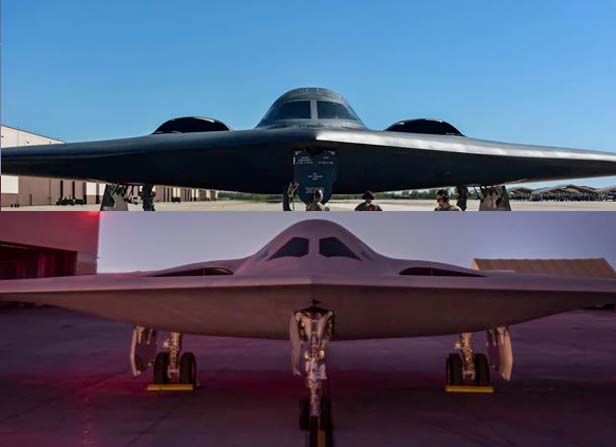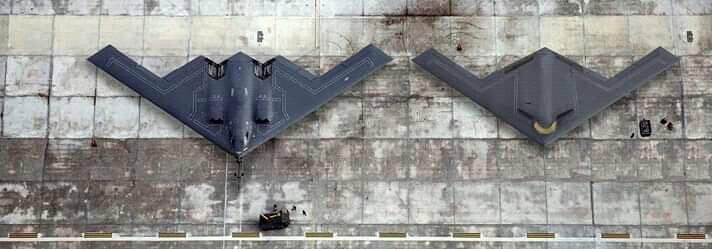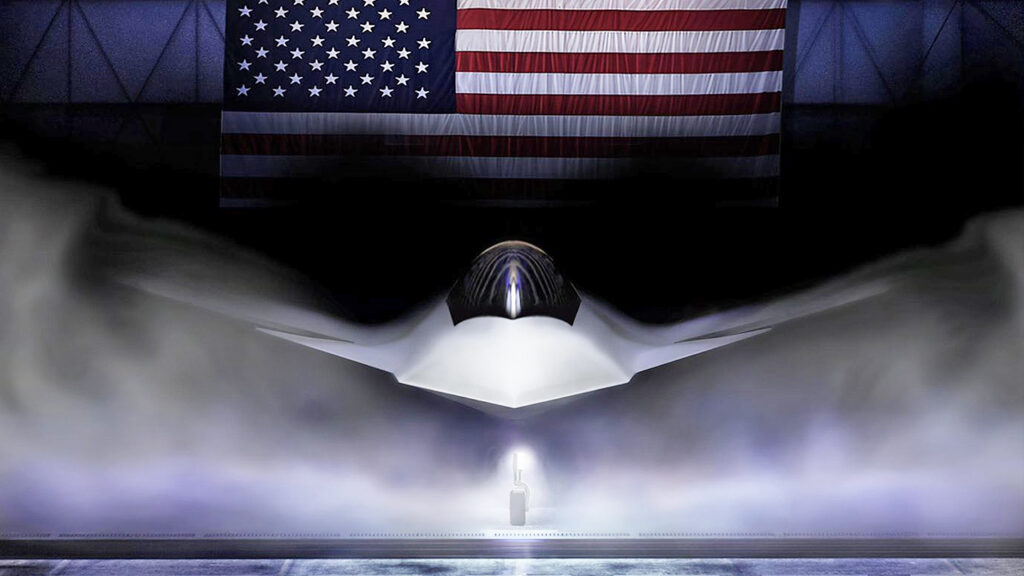Why the B-21 Raider is much more than an updated B-2 Spirit
- By Alex Hollings
Share This Article

On Friday evening, Northrop Grumman and the Air Force finally unveiled America’s new stealth bomber, the B-21 Raider, but almost immediately people began asking — isn’t that just an updated B-2 Spirit?
At first glance, that seems like a pretty logical question to ask. Both bombers utilize a radar-wicking flying-wing design, both are made by the same firm (Northrop Grumman), and the B-21 is the first new American bomber since the B-2. If you think of these aircraft like sedans, you might be tempted to think of the Raider as nothing more than a new model of the same old car… but the B-21 Raider is a perfect example of why you shouldn’t judge a book by its cover, or an aircraft by its general shape.
In fact, based on official statements about the Raider, the similarities between these two bombers aren’t even skin deep.
Related: Here’s your first look at the B-21 Raider
The B-21 is quite a bit smaller than the B-2

Although the exact dimensions of the B-21 Raider have yet to be revealed, it’s quite apparent that this new bomber is much smaller than the Spirit. It’s expected that the B-21 will boast just half of the B-2’s 60,000-pound payload capacity with a wingspan that’s likely at least 15% shorter than the Spirit’s 172 feet. But what the Raider lacks in girth, it intends to make up for in both stealth and volume.
America’s B-2 was originally supposed to be built in much larger numbers, but the combination of its ballooning price tag and the collapse of the Soviet Union made a new nuclear bomber drop a few rungs on Uncle Sam’s priority list in the mid-to-late 1990s. The B-21 hopes to avoid the same fate by keeping development and production costs down — and because neither the threat posed by China nor Russia’s destabilizing behavior in Europe appear to be waning, it seems unlikely that geopolitics will hamper B-21 production quite as they did for its predecessor (for better or worse).
The smaller size of the B-21 benefits its ability to fly undetected through heavily contested airspace, as well as its potential range. With a payload reduction of 50% but a wingspan reduction expected to be closer to 15%, the result is a slimmer aircraft that will be harder to spot on radar while still carrying a massive supply of fuel onboard — granting it unparalleled range and survivability when compared to any other bombers in service today.
Related: Everything you need to know about the B-21 Raider
It’s not the overall shape, but what’s on the inside that counts

It might help to think of the B-21 Raider as your local GameStop video game retailer. The store in your local strip mall may look a lot like those early GameStops from the ’80s on the outside, but the stuff you find inside it is where the differences become apparent. While the early GameStops had shelves packed with copies of Tetris and Duck Hunt, today’s stores come with some slightly more advanced fare.

Northrop Grumman was awarded the contract to build the B-2 Spirit in October of 1981, and the aircraft first took flight in 1988. And, like in video games, there have been some pretty significant technological advances in aviation since the ’80s. The B-21 Raider boasts literally decades’ worth of advancement in its approach to stealth, onboard avionics, and material sciences as compared to the B-2.
“Fifty years of advances in low-observable technology have gone into this aircraft,” Lloyd Austin said. “Even the most sophisticated air-defense systems will struggle to detect a B-21 in the sky.”
While the B-2’s flying-wing design remains an extremely stealthy approach to aviation, there are a number of notable differences in the way the B-21 goes about leveraging it. Among the most noticeable differences are the B-21’s jet inlets, which are more flush with the body of the aircraft to minimize detection, and its less-pronounced nose.

Related: Doolittle’s Raiders: The legendary WWII namesake of the B-21
Material science is hard to spot from a distance
But what isn’t as immediately apparent is the makeup of the skin adorning each aircraft. All stealth platforms are coated in radar-absorbent material capable of having a pronounced effect on the aircraft’s radar return. Current RAM coatings applied to stealth fighters like the F-35 are said to absorb upwards of 70-80% of inbound electromagnetic energy (radar waves), but come with some significant drawbacks — namely, the high degree of maintenance this highly-sensitive (and expensive) material requires.
Northrop has continuously improved upon the RAM coating on the B-2 Spirit since its inception. In 2004, the firm announced a transition to a new type of coating dubbed alternate high-frequency material (AHFM). RAM coatings are highly guarded secrets but based on the investment Northrop and the Air Force have made into the B-21’s RAM, it is likely not only more effective than previous materials, but also tougher and easier to maintain.

Defense Secretary Lloyd Austin even highlighted this in his statements about the Raider during the unveiling on Friday, pointing out that this new bomber will be able to be housed on the flight line under an awning, rather than in climate-controlled hangars as required for the Spirit.
Related: How the B-21 Raider could shift power in the Pacific
The B-21 was designed to be easy to upgrade and add new weapons to

Modularity is currently all the rage in military aviation for good reason. In the past, mission systems consisted of software and hardware that were largely married to one another, meaning upgrading these systems required the replacement of physical components (and a great deal of subsequent testing). The Raider, like the F-35 Joint Strike Fighter, was designed with modular systems that can support software updates and changes to expand its mission or capability sets without gutting its onboard computers.
This means the B-21 will be able to adapt to new systems that are developed in the years to come, whether we’re talking about new stand-off weapons to be launched from the aircraft’s payload bay or new electronic warfare capabilities meant to bolster its ability to operate with impunity inside heavily defended airspace. In other words, the B-21 Raider will be able to keep up with the times even as its forward-leaning design begins to look a bit more dated.
“The Raider was built with open-system architecture, which makes it highly adaptable,” Austin said. “As the United States continues to innovate, this bomber will be able to defend our country with new weapons that haven’t even been invented yet. And the B-21 is multi-functional. It can handle anything from gathering intel, to battle management, to integrating with our allies and partners. And it will work seamlessly across domains, and theaters, and across the joint force.”
The F-35 has already demonstrated the value of open-system architecture, with frequent updates to its onboard systems not only affecting the types of weapons it can carry, but even increasing the fighter’s aerobatic performance as ongoing testing continues to reveal the airframe’s capabilities. Early in the fighter’s operational lifespan, its performance was limited by its onboard computers to ensure the airframe wasn’t overstressed, but as F-35 pilot Hasard Lee once explained, the aircraft has received updates that unlocked better performance simply as it proved evident that the aircraft could withstand it.
Read more from Sandboxx News
Related Posts
Sandboxx News Merch
-

‘AirPower’ Classic Hoodie
$46.00 – $48.00 Select options This product has multiple variants. The options may be chosen on the product page -

‘Sandboxx News’ Trucker Cap
$27.00 Select options This product has multiple variants. The options may be chosen on the product page -

‘Kinetic Diplomacy’ Bumper Sticker (Black)
$8.00 Add to cart

Alex Hollings
Alex Hollings is a writer, dad, and Marine veteran.
Related to: Airpower

The AGM-181 LRSO missile will modernize America’s nuclear triad

Navy will soon announce the contract award for its F/A-XX 6th-generation jet, according to reports

America’s new air-to-air missile is a drone’s worst nightmare

What we can deduce about the Boeing F-47 and its capabilities so far
Sandboxx News
-

‘Sandboxx News’ Trucker Cap
$27.00 Select options This product has multiple variants. The options may be chosen on the product page -

‘AirPower’ Classic Hoodie
$46.00 – $48.00 Select options This product has multiple variants. The options may be chosen on the product page -

‘AirPower’ Golf Rope Hat
$31.00 Select options This product has multiple variants. The options may be chosen on the product page -

‘Sandboxx News’ Dad Hat
$27.00 Select options This product has multiple variants. The options may be chosen on the product page
